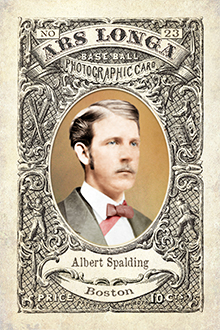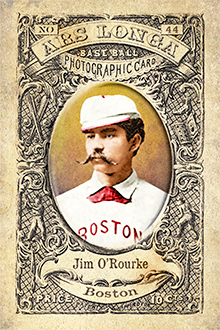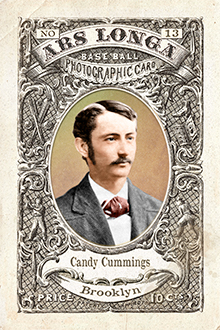- Series: Pioneer Portraits I: 1850-1874
- City: Boston
- Team: Red Stockings (NAPBBP)
- League: National Association (NAPBBP)
- Hall: National Baseball Hall of Fame
Albert Goodwill Spalding (1850-1915) was an elite pitcher who retired at age 27 and proceeded to influence the game as few others have. He helped organize the National League, co-founded A.G. Spalding sporting goods, published the game’s first official rules, traveled the world to promote baseball, owned the White Stockings and led an Olympics, leaving one of the great legacies in sport.
- Was a five-time pennant winner with the Boston Red Stockings and Chicago White Stockings
- Career 252-65 record with a .796 winning percentage
- Elected to Hall of Fame: 1939
- Series: Pioneer Portraits I: 1850-1874
- City: Boston
- Team: Red Stockings (NAPBBP)
- League: National Association (NAPBBP)
- Hall: National Baseball Hall of Fame
James Henry O’Rourke (1850-1919) made the National League’s first base hit, and went on to a 21-year, Hall of Fame career. From 1876-92, only Cap Anson played in more games or got more hits. After leaving MLB for the minors, O’Rourke returned for his swan song with his pal John McGraw’s Giants, becoming the oldest player (at 54) to play in the NL and to get a hit.
- Played for 5 pennant winners and was NA HR champ in 1874-75
- One of only 29 to play in MLB in four decades
- One of the first 19th century players to be elected to HOF
- Elected to Hall of Fame: 1945
- Series: Pioneer Portraits I: 1850-1874
- City: Brooklyn
- Team: Star of Brooklyn
- League: National Association (NABBP)
- Hall: National Baseball Hall of Fame
William Arthur Cummings (1848-1924) has a plaque in Cooperstown today, not because of his won-lost record or ERA – both of which were excellent; but primarily because he is credited with inventing the curveball, and was able to throw it effectively under the combat conditions of early baseball. A star for the Brooklyn clubs in the old NABBP in the 1860s, Cummings continued to be effective in the pro era until 1877.
- Cummings got the idea for the curve from a day at the beach chucking clam shells
- Once catcher Nat Hicks moved close behind the batter, the curve became a viable pitch
- Elected to Hall of Fame: 1939
- Series: Pioneer Portraits I: 1850-1874
- City: New York
- Hall: National Baseball Hall of Fame
Henry Chadwick (1824-1908) is widely considered the “Father of Baseball” due to his profound influence on early public awareness of the game and upon its foundational rules. A journalist from Brooklyn, Chadwick was present at the creation as he saw the new game developing in the 1860s and began what would become sports reporting today.
- Literally wrote the book on baseball: Beadle’s Dime Base Ball Player in 1860
- Edited Spalding’s Official Base Ball Guide for decades
- Saw to it we don’t have tie games or one-bounce outfield put-outs today
- Elected to Hall of Fame: 1938
- Series: Pioneer Portraits I: 1850-1874
- City: New York
- Team: Knickerbockers
- Hall: National Baseball Hall of Fame
Alexander Joy Cartwright (1820-1892) was declared the inventor of baseball by an act of Congress in 1953. A founding member of the Knickerbocker Base Ball Club in 1842, Cartwright is oftentimes falsely credited with establishing the 9 player “diamond” format in 1845. Modern researchers have largely debunked the historical import of Cartwright’s influence upon the game, its rules and development during those early formative stages, citing a propagandizing campaign by Cartwright’s son as a primary source of myth-making.
- The Knickerbocker rules form the foundation of the modern game
- Thanks to such rules, runners are no longer “tagged out” via thrown balls
- The diamond’s dimensions were termed by Red Smith “the closest man has ever come to perfection.”
- Elected to Hall of Fame: 1938




